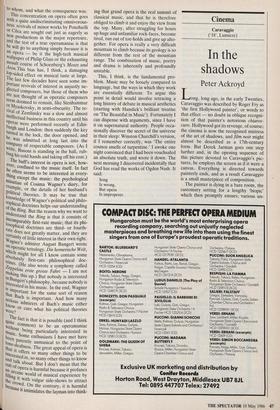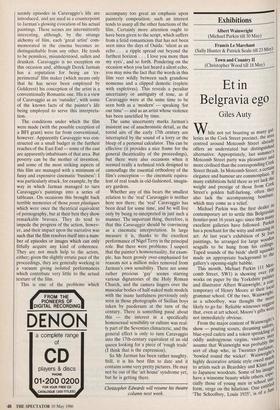Cinema
In the shadows
Peter Ackroyd
Long, long ago, in the early Twenties, Caravaggio was described by Roger Fry as 'the first Hollywood painter', or words to that effect — no doubt in oblique recogni- tion of that painter's notorious chiaros- curo. Hollywood got its revenge, of course; the cinema is now the recognised mistress of the art of shadows, and film noir might almost be described as a 17th-century form. But Derek Jarman goes one step further and, in the opening sequence of this picture devoted to Caravaggio's pic- tures, he employs the screen as if it were a canvas. Everything is directed towards painterly ends, and as a result Caravaggio is a small masterpiece of composition.
The painter is dying in a bare room, the customary setting for a lengthy 'biopic' which then promptly ensues; various un- seemly episodes in Caravaggio's life are introduced, and are used as a counterpoint to Jarman's glowing evocation of his actual paintings. These scenes are intermittently interesting, although, by the strange alchemy of film, each 'great artist' com- memorated in the cinema becomes in- distinguishable from any other. He tends to be penniless, misunderstood, sullen and drunken. Caravaggio is no exception on this occasion and, although Derek Jarman has a reputation for being an 'ex- perimental' film maker (which means only that he has never been employed by Goldcrest) his conception of the artist is a conventionally Romantic one. His is a view of Caravaggio as an 'outsider', with some of the known facts of the painter's life being employed to serve this interpreta- tion.
The conditions under which the film were made (with the possible exception of a BFI grant) were far from conventional, however. Apparently Caravaggio was con- structed on a small budget in the furthest reaches of the East End — some of the cast are apparently inhabitants of that area. But poverty can be the mother of invention, and some of the most striking aspects of this film are managed with a minimum of fussy and expensive cinematic 'business': I was particularly struck, for example, by the way in which Jarman managed to turn Caravaggio's paintings into a series of tableaux. On occasions this brought back terrible memories of those poses plastiques which were once the theatrical equivalent of pornography, but at their best they show remarkable bravura. They do tend to impede the progress of the action, howev- er, and their impact upon the narrative was such that the film resolves itself into a num- ber of episodes or images which can only fitfully acquire any kind of coherence. They are not much help to the actors, either; given the slightly erratic pace of the proceedings, they are generally working in a vacuum giving isolated performances which contribute very little to the actual texture of the film.
This is one of the problems which accompany too great an emphasis upon painterly composition: such an interest tends to usurp all the other functions of the film. Certainly more attention ought to have been given to the script, which suffers from a fetid romanticism that has not been seen since the days of Ouida: 'silent as an echo . . . a ripple spread out beyond the furthest horizon. . . I love you more than my eyes', and so forth. Pondering on the occasion when you last heard a silent echo, you may miss the fact that the words in this film veer wildly between such grandiose nonsense and a clipped demotic (replete with expletives). This reveals a peculiar uncertainty or ambiguity of tone, as if Caravaggio were at the same time to be seen both as a 'modern' — speaking 'for our time' — and as an artist whose violence has been sanctified by time.
The same uncertainty marks Jarman's insistent use of anachronistic detail, as the torrid airs of the early 17th century are interrupted by the sound of a lorry or the bleep of a personal calculator. This can be effective (it provides a nice frame for the general theatricality of the proceedings), but there were also occasions when it seemed really a technical trick designed to camouflage the essential orthodoxy of the film's conception — the cinematic equiva- lent of real toads in old-fashioned, imagin- ary gardens.
Whether any of this bears the smallest relation to the 'real' Caravaggio is neither here nor there; the 'real' Caravaggio has been dead for some time, and he will live only by being re-interpreted in just such a manner. The important thing, therefore, is that this Caravaggio should be convincing as a cinematic interpretation. In large measure it is, thanks to the excellent performance of Nigel Terry in the principal role. But there were problems: I suspect that the painter's homosexuality, for exam- ple, has been grossly over-emphasised for reasons not a million miles removed from Jarman's own sensibility. There are some rather precious 'gay' scenes starring various dignatories of the Holy Roman Church, and the camera lingers over the muscular bodies of half-naked male models with the inane lustfulness previously only seen in those photographs of Sicilian boys taken by paederasts at the turn of the century. There is something passé about this — the interest in a specifically homosexual sensibility or culture was real- ly part of the Seventies climacteric, and the general effect is only to turn Caravaggio into the 17th-century equivalent of an old queen looking for a piece of 'rough trade' (I think that is the expression).
So Mr Jarman has been rather naughty. Still, it is his best film to date and it contains some very pretty pictures. He may not be out of the 'art house' syndrome yet, but he is getting there.
Christopher Edwards will resume his theatre column next week.



























































 Previous page
Previous page